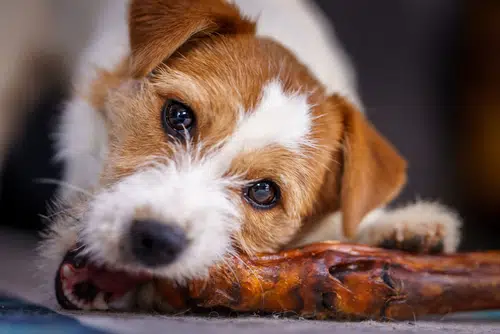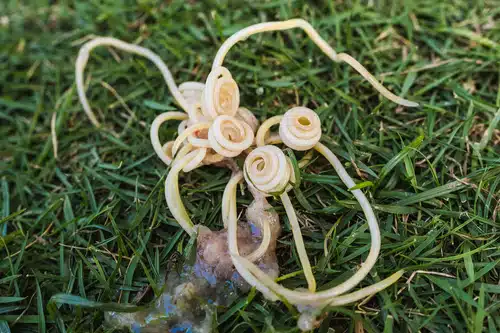Home » Blog » Pet » Pet Health & Safety » Can Dogs Eat Bones? Raw, Cooked, Lamb, Chicken, Ham?
Categories
Tags
animal welfare
breed profile
buying a car
buying a pet
Car
car accessories
car care
car features
car insurance
Car safety
car sales
car service
cat
cat behaviour
cat body language
Cat Breeds
cat food
cat insurance
comprehensive car insurance
Dog
Dog Behaviour
dog body language
Dog Breeds
dog food
Dog Insurance
dog training
eco friendly cars
Kitten
New Car
pet accessories
pet activities
Pet Adoption
pet breeders
pet days of the year
pet fun stuff
Pet Health
pet insurance
pet parenting
Pet Safety
pet services
Puppy
rescue pets
road safety
road trip
safe driving
Recent Blog:
Facebook Posts
3 hours ago
Are intestinal worms setting up camp in your dog’s gut without paying rent? Here’s how to spot the main culprits and get rid of them too:![]()
![]() Preventing, Identifying and Treating Intestinal Worms in Dogs - bit.ly/43YjCKu
... See MoreSee Less
Preventing, Identifying and Treating Intestinal Worms in Dogs - bit.ly/43YjCKu
... See MoreSee Less
Preventing, Identifying and Treating Intestinal Worms in Dogs
www.pd.com.au
Intestinal worms, such as roundworms in dogs are one of the least glamorous topics on the planet. These intestinal parasites that basically use our dogs
PD Insurance
with Dogs West.
2 days ago
We enjoyed meeting #breeders #doglovers and members at the Dogs West Open Day. Special thanks to our partner Dogs West for organising an incredible event. There is still time to enter our pawsome competition. Click here for details: bit.ly/4covyce![]() #PDinsurance #dogswestopenday #dogswest
... See MoreSee Less
#PDinsurance #dogswestopenday #dogswest
... See MoreSee Less
2 days ago
Did you know? The Manx is a breed that is known for its lack of a tail, which is caused by a genetic mutation.
... See MoreSee Less
A bone is the quintessential treat for a dog. There’s everything from AC/DC songs to popular sayings around dogs and bones. But in reality, can dogs eat bones? Does it make a difference if we’re talking chicken, or lamb? Can dogs eat cooked bones? Or raw bones?
Turns out, there are quite a few factors to consider before you toss that leftover bone to your dog. Not only does the type of bone matter, but so does the size and preparation.
So for all your questions around whether dogs can eat bones, we have the answers.
Can dogs eat raw bones?
You might have heard that dogs should eat bones. It’s true that chewing is good for dog’s teeth and general dental health. And it’s also true that chewing a bone can stop your dog chewing shoes or a carpet. Or reduce it, anyway.
Chewing is a natural dog behaviour, and there are safe dog chews and bones available. In fact, dog bones can provide mental stimulation and keep your dog’s teeth clean. But before you hand over any old bone, read on to learn about which bones are safe for dogs.
The reality is, opinion is still divided from vets and animal experts when it comes to the age-old question of ‘can dogs eat bones?” While some say it’s healthy, safe, and normal (with the right precautions in place!), others say you should err on the side of caution and avoid bones altogether.
Let’s look at what the science says about dogs eating cooked bones, raw bones, chicken bones, lamb bones, bone toys, and every other type of bone you’ve wondered about.
First up, what about the leftover bone from that juicy roast beef? Are cooked bones safe for dogs?
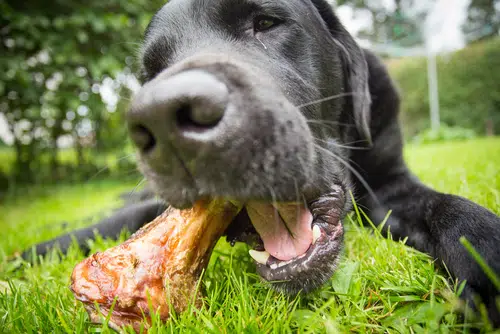
Can dogs eat cooked bones?
Can dogs eat cooked bones? It’s all too easy to throw them the bone from your barbecued ribs or a leftover roast dinner. No need to buy your dog separate bones; you can just share your dinner with them… Right?
No. If there’s one rule you should follow when it comes to bones and dogs, it’s this: no cooked bones, ever. Opinion might be divided on some of the finer points around safety and dogs eating bones, but everyone agrees on this. Why? It’s a huge safety hazard.
Why is it an issue?
Dog owners often know that dogs can’t eat cooked chicken bones, because the dangers are well documented. We know they can splinter and cause choking or pierce your dog’s digestive tract. But for some reason, the dangers of other bones aren’t as well known.
Any cooked bones can cause problems like:
- Mouth, tongue, and teeth injuries
- Bones stuck around the dog’s lower jaw
- Digestive tract blockage
- Choking (read about dog choking and ingestion risks here)
- Constipation
- Peritonitis (a bacterial infection of the abdomen caused by punctures in the stomach or intestines)
So if you’re wondering whether your dog can eat lamb bones cooked, ham bones cooked, or even cooked beef bones, the answer is still a resounding no.
Can dogs eat chicken bones, raw or cooked?
Chicken is a common dinner staple for most Aussies. So a lot of us have wondered if dogs can eat chicken bones. After all, with a roast chicken hitting the table pretty regularly, it’d be an easy treat for your pup.
Can dogs eat cooked chicken bones? As we mentioned above, raw bones of any type should always be avoided. They’re simply not safe for your dog.
But what about raw chicken bones? These are safer for dogs than cooked, and some experts recommend feeding them. That said, some vets say never to feed bones of any type.
If you do want your dog to eat bones though, raw bones are safer. Chicken bones are easier to digest than big bones from beef or pork, and can also be chewed into very small pieces. That’s why things like chicken necks and feet are often recommended.
Dogs can benefit from the cartilage chicken bones contain. Plus, chewing can help clean their teeth and remove tartar. For this reason, some people also feed chicken wings.
If your dog is likely to wolf them down whole (which is common in bigger dogs, or just those who are more swallowers than chewers at feed time. We’re looking at you, Labrador Retriever!) then obviously, this could pose a choking risk. You know your dog best, so if they fall into this category you may want to skip chicken bones and opt for large, raw meaty bones instead like cow hock or kangaroo leg.
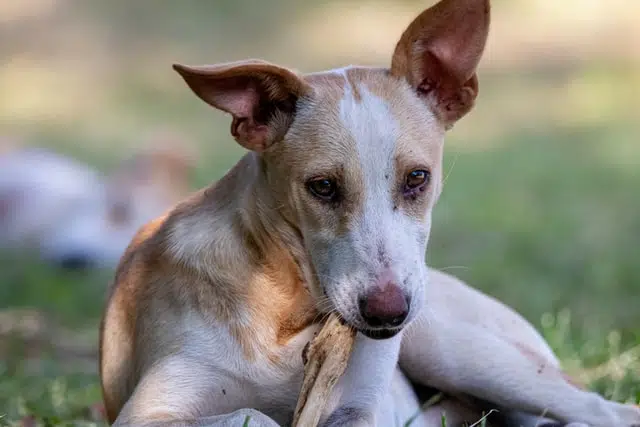
Can dogs eat lamb bones?
Though your dog can’t eat cooked lamb bones, they can eat raw lamb bones. As long as they’re appropriately sized and have the excess fat trimmed off, that is. They’re not as easy to digest as chicken bones, so if your dog eats lamb bones, you’ll want them to chew, gnaw, and lick them rather than swallow pieces.
Remember that lamb bones are quite small. So you have to be careful about which ones you use. Especially if you have a large dog or – as mentioned above – one who tends to swallow things whole rather than chew and savour them. You should stick to bones like leg or hip, and make sure to supervise your dog when they’re eating them.
Once the bones reach a size where they can be swallowed or broken, take them away.
What about bone treats from the shop?
Most pet shops have a variety of different treat-type bones. These vary from Nylabone-type toys, to rawhide chews, to actual bones. Can dogs eat these bones? And which ones are best? Where do you even start?
One option is dental chews, which are often shaped like toothbrushes. They’re digestible and satisfy the need to chew while also helping to promote good dental health. Then there are toys designed for chewing, but not necessarily eating.
Is rawhide bad for dogs? Yes, it can be. Instead, opt for something like nylabone which is durable and generally pretty hard for dogs to destroy. Although we know some dogs would take that as a challenge!
You’ll also find a variety of chews which are made from meat, cartilage, and muscle of animals – think trachea or bully sticks. These are easily digestible and a good choice if you’re still worried about bones. Just make sure to choose ones which are Australian-made without additives and fillers. Then you’ll be supporting sustainable dog food and treat producers, as well as making a healthier choice for your pup.
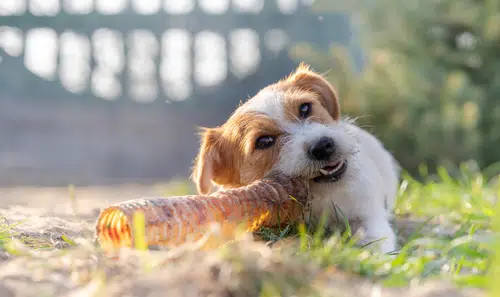
What else should you know?
Finally, remember that while dogs can eat raw bones of the right size, these are treats and should form part of a balanced diet. Whether you choose to feed raw for your dog or go for traditional dry or wet dog food is up to you – but bones shouldn’t be something you rely on to keep them healthy and well-fed.
Also remember that your dog should be supervised while eating bones. That way, you can monitor their consumption and remove the bones when they become dangerous. Plus, you’ll know if they start to choke.
Dog insurance
You know the saying ‘he’s like a dog with a bone’ – but if your pup does actually get into the chicken bones, you’ll want to make sure you can visit the vet. After all, even the most vigilant owners can’t prevent the occasional injury, illness, or mishap.
Which is where a dog insurance policy comes in. That way, you can get them checked out without feeling the pinch as badly. And if you’re invested in your dog’s teeth, as you should be, then the PD Insurance Deluxe plan also provides dental cover. Now that’s a reason to smile!
Share On:

